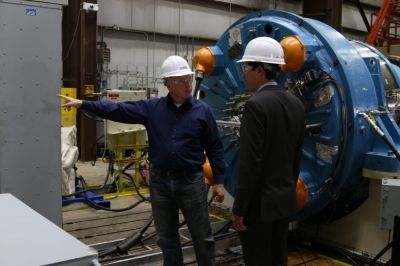Innovative Drivetrain Testing for Wind Turbines Nears Completion
Wind energy researchers have entered the final phase of testing a next-generation drivetrain—made up of the components of a wind turbine that convert the rotational energy of the rotor into electricity that will be less expensive, more reliable and more efficient. This project, funded by the U.S. Department of Energy (DOE), combines innovations across the entire drivetrain system including the gearbox, generator, and power converter.
According to project lead Jonathan Keller, senior engineer at the National Renewable Energy Laboratory (NREL), the technology is meeting design projections and working as researchers expected. This is great news for the project, which features several unique aspects—from advanced technologies to the laboratory test facilities and public/private collaborations—that make the work possible.
The effort began with a 2010 DOE solicitation funding projects to develop wind turbines that are cheaper, lighter, more efficient, and more reliable. In response, NREL convened its industry partners CREE, DNV GL and Romax Technology to combine their technologies into one innovative drivetrain design.
DOE funded more than half of the project’s $3 million design, build, and test budget. The industry partners supplied expertise, hardware design, development and fabrication, labor, parts, and equipment. NREL facilitated the project and provided research staff, cost-of-energy modeling, and testing in state-of-the-art facilities designed to put the drivetrain through its paces. These include:
The 2.5-megawatt dynamometer facility: After connecting it to the dynamometer, researchers tested the drivetrain in realistic operational conditions to validate design tools and increase the technical readiness of the innovations.
The controllable grid interface:Unique to the National Wind Technology Center, the controllable grid interface allowed researchers to simulate real-time changes in the utility grid in a controlled environment, giving them a better understanding of how the drivetrain technology will react to grid disturbances. Keller describes the new drivetrain system as a “technology testbed” that uses sophisticated hardware and software that can be incorporated into different gearboxes, converters and wind turbines. These components include a:
Simplified gearbox: The single-stage, medium-speed gearbox is smaller, simpler and lighter than commonly used three-stage drivetrains and its configuration improves the load distribution and increases the drivetrain’s overall reliability. Low-speed journal bearings support the planets (or gears) and feature a cavity filled with pressurized oil that recirculates throughout the gearbox, keeping parts lubricated and running smoothly. Flexible pins (or axles) have an S-shape that allows them to flex, preventing misalignment of gear-tooth flanks, keeping the gears level and ensuring equal load sharing among the four gears.
Permanent-magnet generator: The medium-speed, medium-voltage generator features concentrated, segmented windings that decrease manufacturing and operation and maintenance costs.
High-efficiency power converter: Incorporating software that uses a unique fault-control algorithm, the power converter dampens the effect of grid fluctuations on the gearbox by tempering sudden changes, improving reliability and reducing operation and maintenance costs. In addition, medium-voltage, wide-bandgap power modules significantly reduce losses within the power converter, leading to increased efficiency, energy capture and revenue.
By studying the drivetrain system as a whole and understanding how mechanical and electrical systems interact, researchers and industry collaborators took the best of each part of the system to advance the state of the art. Once testing is complete, these drivetrain technologies will enter the marketplace to support DOE’s goals of improving wind turbine drivetrain reliability while significantly lowering operations, maintenance, and deployment costs.




